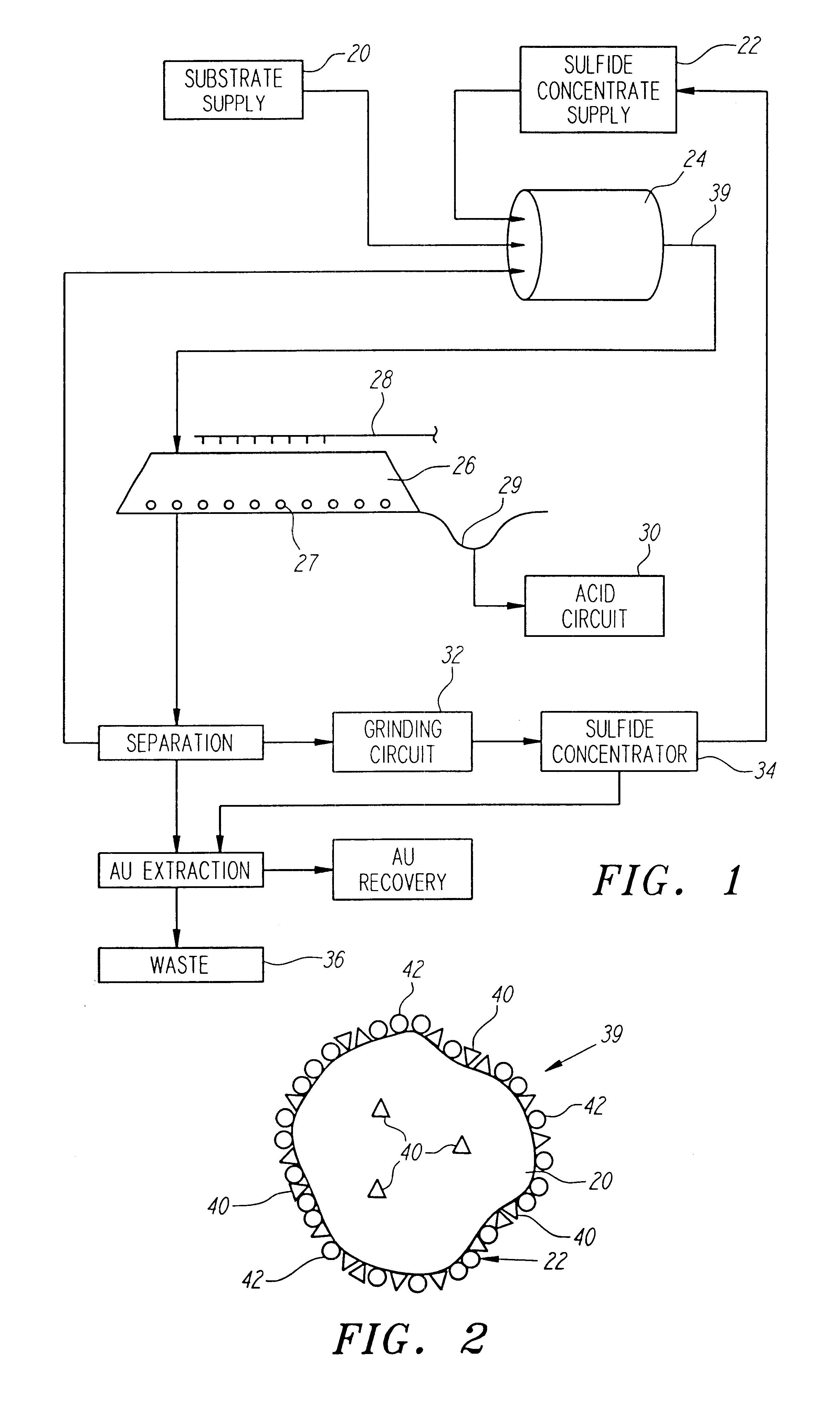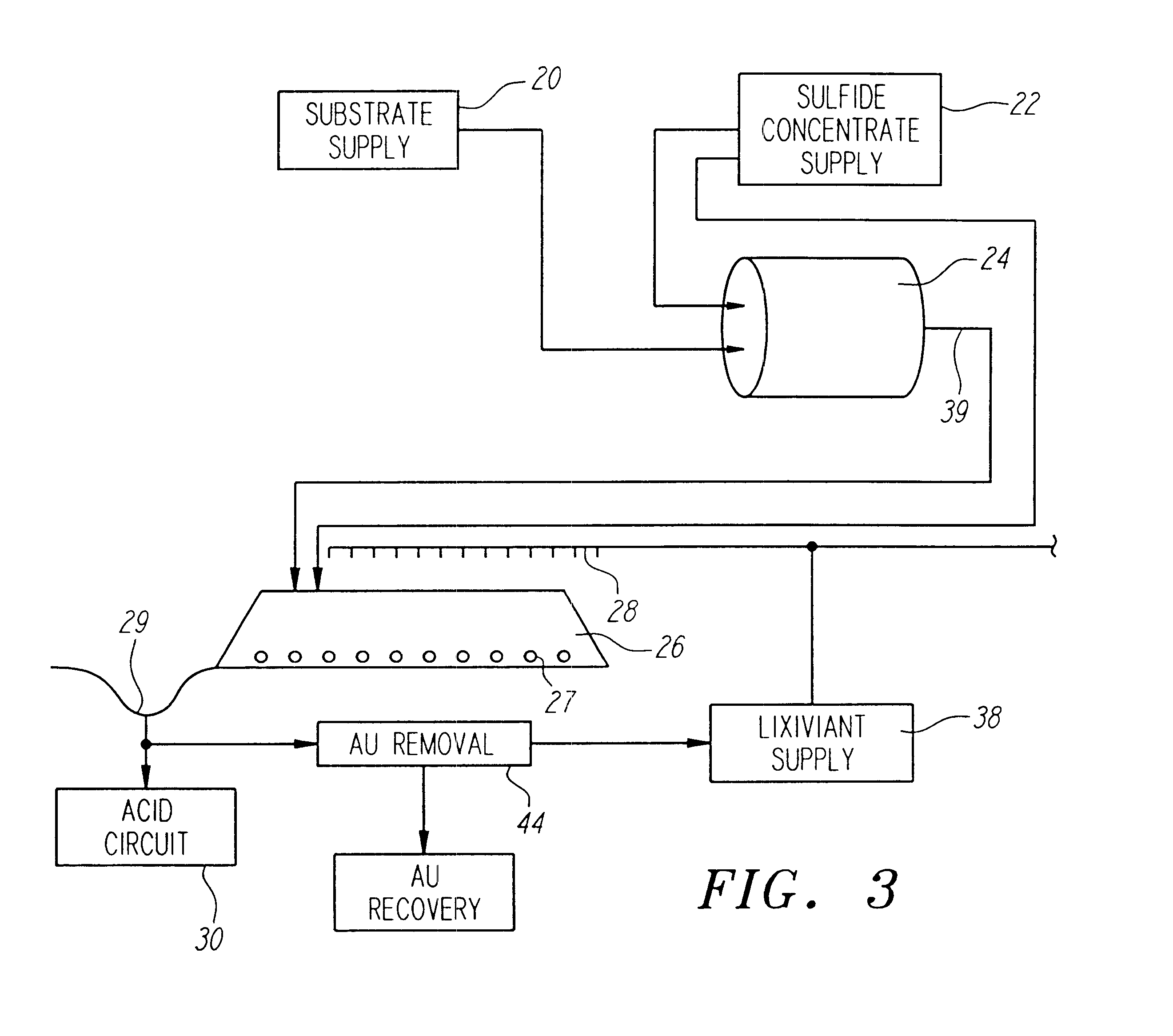Method of biotreatment for solid materials in a nonstirred surface bioreactor
a bioreactor and solid material technology, applied in the direction of dissolving, inorganic carrier, borehole/well accessories, etc., can solve the problem of slowing down and achieve the effect of improving the rate at which the biotreatment process progresses and increasing the capacity of the bioreactor
- Summary
- Abstract
- Description
- Claims
- Application Information
AI Technical Summary
Benefits of technology
Problems solved by technology
Method used
Image
Examples
example 2
Another comparative test was made. In this example, the biooxidation rates of ore size fractions were compared. The ore, which was provided by the Ramrod Gold Corporation, was crushed to 1.9 cm. The -0.31 cm ore fraction was removed and used to form a concentrate. The ore sample had less than 0.08 oz. of gold per ton of ore (2.7 ppm). The sample contained both arsenopyrite and pyrite. The concentrate was made by ball milling 5 Kg of the -0.31 cm inch ore until it passed -75 .mu.m, the ball milled ore was then floated with Xanthate to form a pyrite concentrate. Before flotation clay was removed by settling with Na.sub.2 SiO.sub.3 at 6 Kg / tonne of ore for 8 hours or more. The flotation was done in small batches of 500 g each in a laboratory Wemco flotation cell. Potassium Amyl Xanthate was used as a collector at a concentration of 100 g / tonne along with sodium sulfide at 1.5 Kg / tonne and Dowfroth D-200 at 50 g / tonne. The pyrite concentrate constituted 4.5% of the weight of the -0.31 c...
example 3
A sample of 70% minus 75 .mu.m gold ore from a mine in the Dominican Republic was used to make a sulfide float concentrate. The ore sample was obtained from the tailing pile at the mine that had already been leached with cyanide. The ore sample still contained gold values of over 2 g per tonne which were occluded within the sulfides and not directly leachable by cyanide.
To form the sulfide concentrate, several kilograms of this sample were further ground to 95% minus 75 .mu.m. The ground sample was then floated to form the sulfide concentrate. The flotation was done in small batches of 500 g each in a laboratory Wemco flotation cell. Before flotation, the ground ore sample was adjusted to a pulp density of 30%. The ore slurry was then mixed with 1.5 Kg / tonne sodium sulfide (Na.sub.2 S) for 5 minutes at pH 8.5. Then potassium amyl Xanthate was added as a collector at 100 g / tonne and mixed for 5 minutes. Next 50 g / tonne of Dowfroth D-200 was added and mixed for 5 minutes. Finally, air...
example 4
A sample of gold bearing refractory sulfide ore that had been crushed to 80% passing 0.62 cm was prepared for testing as support rock. The ore was from the Western States mine located in Nevada, and contained a high concentration of carbonate minerals in the form of limestone. The fine material (less than 0.31 cm) was removed in order to allow for good air flow. A four kilogram sample of the +0.31 cm to -0.62 cm rock was coated with one kilogram of a gold bearing pyrite concentrate provided by another mining company. The coating was formed by placing a the coarse ore substrates and dry concentrate into a small rotating drum and spraying the mixture with a liquid which contained 2,000 ppm ferric ion and 1% Nalco #7534 agglomeration aid until all the sulfide concentrate was coated onto the wetted granite rock.
Iron analysis of both samples showed that the concentrate contained 210 grams of iron and the four kilograms of support rock contained 42.8 grams of iron.
The five kilograms of co...
PUM
| Property | Measurement | Unit |
|---|---|---|
| particle size | aaaaa | aaaaa |
| particle size | aaaaa | aaaaa |
| surface area | aaaaa | aaaaa |
Abstract
Description
Claims
Application Information
 Login to View More
Login to View More - R&D
- Intellectual Property
- Life Sciences
- Materials
- Tech Scout
- Unparalleled Data Quality
- Higher Quality Content
- 60% Fewer Hallucinations
Browse by: Latest US Patents, China's latest patents, Technical Efficacy Thesaurus, Application Domain, Technology Topic, Popular Technical Reports.
© 2025 PatSnap. All rights reserved.Legal|Privacy policy|Modern Slavery Act Transparency Statement|Sitemap|About US| Contact US: help@patsnap.com



